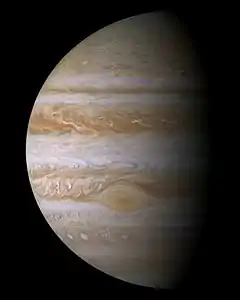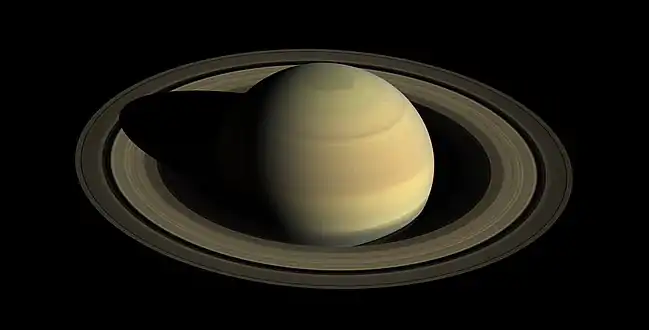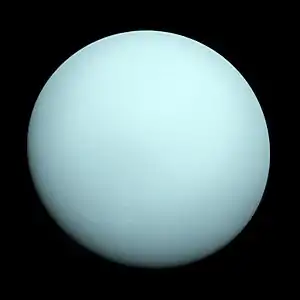List of missions to the outer planets
A total of nine spacecraft have been launched on missions that involve visits to the outer planets; all nine missions involve encounters with Jupiter, with four spacecraft also visiting Saturn. One spacecraft, Voyager 2, also visited Uranus and Neptune. The nine missions include two; Ulysses and New Horizons, whose primary objectives are not related to the outer planets, but which flew past Jupiter to gain gravity assists en route to a polar orbit around the Sun, and Pluto—at the time of its launch considered an outer planet—respectively. Cassini–Huygens also flew past Jupiter for a gravity assist on its Mission to explore Saturn.
Only three of the missions to the outer planets have been orbiters: Galileo orbited Jupiter for eight years, while Cassini orbited Saturn for thirteen years. Juno has been orbiting Jupiter since 2016.
Summary
System Spacecraft |
Jupiter Jupiter trojans |
Saturn | Uranus Uranus trojans |
Neptune Neptune trojans |
Pluto Haumea Makemake Eris |
Distant minor planets |
|---|---|---|---|---|---|---|
| Pioneer 10 | 1973 flyby Jupiter and moons |
|||||
| Pioneer 11 | 1974 flyby Jupiter and moons |
1979 flyby Saturn and moons |
||||
| Voyager 1 | 1979 flyby Jupiter and moons |
1980 flyby Saturn and moons |
||||
| Voyager 2 | 1979 flyby Jupiter and moons |
1981 flyby Saturn and moons |
1986 flyby Uranus and moons |
1989 flyby Neptune and moons |
||
| Galileo | 1995–2003 orbiter Jupiter and moons 1995, 2003 atmospheric Jupiter |
|||||
| Ulysses | 1992, 2004 gravity assist Jupiter |
|||||
| Cassini–Huygens | 2000 gravity assist Jupiter and moons |
2004–2017 orbiter Saturn and moons 2005 lander Titan |
||||
| New Horizons | 2007 gravity assist Jupiter and moons |
2015 flyby Pluto and moons |
2019 flyby 486958 Arrokoth | |||
| Juno | 2016–2021 orbiter Jupiter |
|||||
| Europa Clipper | 2026– Planned orbiter Jupiter flyby Europa |
|||||
| Lucy | 2027– Planned flyby 3548 Eurybates 15094 Polymele 11351 Leucus 21900 Orus 617 Patroclus |
|||||
| Jupiter Icy Moons Explorer | 2029– Planned orbiter Jupiter and moons Planned orbiter Ganymede |
|||||
| Dragonfly | 2034 Planned lander Titan |
Jupiter
Six spacecraft have been launched to explore Jupiter, with spacecraft making gravity-assist flybys.
New Horizons, although eventually targeting planet Pluto, used Jupiter for a gravity assist and had an extensive almost half year observation campaign of Jupiter and its moons.[1]
| Spacecraft | Launch Date | Operator | Mission | Outcome | Remarks | Carrier rocket |
|---|---|---|---|---|---|---|
| Pioneer 10 | 3 March 1972[2] | NASA United States |
Flyby | Successful[3] | Closest approach at 02:25 UTC on 4 December 1973[4] | Atlas SLV-3C Centaur-D[5] |
| Pioneer 11 | 6 April 1973[2] | NASA United States |
Flyby | Successful[6] | Closest approach at 05:22 UTC on 3 December 1974, later flew past Saturn[7] | Atlas SLV-3D Centaur-D1A[5] |
| Voyager 2 | 20 August 1977[2] | NASA United States |
Flyby | Successful | Closest approach at 22:29 on 9 July 1979, later flew past Saturn, Uranus and Neptune[8] | Titan IIIE Centaur-D1T[9] |
| Voyager 1 | 5 September 1977[2] | NASA United States |
Flyby | Successful | Closest approach at 12:05 UTC on 5 March 1979, later flew past Saturn[10] | Titan IIIE Centaur-D1T[9] |
| Galileo | 18 October 1989[2] | NASA United States |
Orbiter/Atmospheric | Successful[11] | Atmospheric probe entered atmosphere at 22:04 UTC on 7 December 1995 and operated for 57 minutes; main spacecraft entered orbit at 00:27 UTC on 8 December.[12] Spacecraft was deorbited on 21 September 2003, impacting Jupiter's atmosphere at 18:57:18 UTC.[13] | Space Shuttle Atlantis STS-34 / IUS[14] |
| Ulysses | 6 October 1990[2] | NASA United States / ESA |
Gravity assist | N/A | Flyby on 8 February 1992 to reach a high-inclination heliocentric orbit.[15] Also made a distant incidental flyby on 4 February 2004[16] | Space Shuttle Discovery STS-41 / IUS[17] |
| Cassini–Huygens | 15 October 1997[2] | NASA United States / ESA |
Gravity assist | N/A | Flyby on 30 December 2000 en route to Saturn[18] | Titan IV(401)B Centaur-T[19] |
| New Horizons | 19 January 2006[2] | NASA United States |
Gravity assist[20] Major observation campaign from Jan-June[21] |
Successful | Flyby on 28 February 2007 (closest approach at 05:43:40[22]) en route to Pluto[23] | Atlas V 551[20] |
| Juno | 5 August 2011[2] | NASA United States |
Orbiter | Operational | Entered orbit 4 July 2016[24] | Atlas V 551[25] |
- Missions whose primary objectives were not related to the exploration of Jupiter are indicated in grey
Saturn
Four spacecraft have visited Saturn; Pioneer 11, Voyager 1 and Voyager 2 made flybys, while Cassini–Huygens entered orbit, and deployed a probe into the atmosphere of Titan.
| Spacecraft | Launch Date | Operator | Mission | Outcome | Remarks | Carrier rocket |
|---|---|---|---|---|---|---|
| Pioneer 11 | 6 April 1973[2] | NASA United States |
Flyby | Successful | Closest approach on 1 September 1979 at 16:31 UTC[7] | Atlas SLV-3D Centaur-D1A[5] |
| Voyager 2 | 20 August 1977[2] | NASA United States |
Flyby | Successful | Closest approach at 01:21 UTC on 26 August 1981, later flew past Uranus and Neptune[8] | Titan IIIE Centaur-D1T[9] |
| Voyager 1 | 5 September 1977[2] | NASA United States |
Flyby | Successful | Closest approach on 12 November 1980 at 23:45 UTC[10] | Titan IIIE Centaur-D1T[9] |
| Cassini | 15 October 1997[2] | NASA United States |
Orbiter | Successful | Entered orbit 1 July 2004; mission concluded on September 15, 2017[26] | Titan IV(401)B Centaur-T[19] |
| Huygens | 15 October 1997[2] | ESA / ASI Italy |
Titan lander | Successful | Deployed from Cassini; landed on Titan at 10:13 UTC on 14 January 2005 | Titan IV(401)B Centaur-T[19] |
Uranus
Voyager 2 is the only spacecraft to have visited Uranus, making a single flyby as part of its grand tour of the outer planets.
| Spacecraft | Launch Date | Operator | Mission | Outcome | Remarks | Carrier rocket |
|---|---|---|---|---|---|---|
| Voyager 2 | 20 August 1977[2] | NASA United States |
Flyby | Successful | Closest approach at 17:59 UTC on 24 January 1986, later flew past Neptune[8] | Titan IIIE Centaur-D1T[9] |
Neptune
Voyager 2 is also the only spacecraft to have visited Neptune, making a single flyby as part of its grand tour of the outer planets.
| Spacecraft | Launch Date | Operator | Mission | Outcome | Remarks | Carrier rocket |
|---|---|---|---|---|---|---|
| Voyager 2 | 20 August 1977[2] | NASA United States |
Flyby | Successful | Closest approach at 03:26 UTC on 25 August 1989[8] | Titan IIIE Centaur-D1T[9] |
See also
- List of trans-Neptunian objects (numbered, excludes comets, see Trans-Neptunian object)
- Interstellar probe
- Kuiper belt (approx. 30-50 AU, Pluto largest of this group)
References
- McDowell, Jonathan. "Launch Log". Jonathan's Space Page. Retrieved 6 January 2013.
- "Solar System Exploration - Pioneer 10". NASA. Retrieved 6 January 2013.
- "Solar System Exploration - Pioneer 10". NASA. Retrieved 6 January 2013.
- Krebs, Gunter. "Pioneer 10, 11, H". Gunter's Space Page. Retrieved 6 January 2013.
- "Solar System Exploration - Pioneer 11". NASA. Retrieved 6 January 2013.
- "Solar System Exploration - Pioneer 11". NASA. Retrieved 6 January 2013.
- "Solar System Exploration - Voyager 2". NASA. Retrieved 6 January 2013.
- Krebs, Gunter. "Voyager 1, 2". Gunter's Space Page. Retrieved 6 January 2013.
- "Solar System Exploration - Voyager 1". NASA. Retrieved 6 January 2013.
- "Solar System Exploration - Galileo". NASA. Retrieved 6 January 2013.
- "Solar System Exploration - Galileo". NASA. Retrieved 6 January 2013.
- "Solar System Exploration - Galileo - Dates". NASA. Retrieved 6 January 2013.
- Krebs, Gunter. "Galileo". Gunter's Space Page. Retrieved 6 January 2013.
- "Solar System Exploration - Ulysses". NASA. Retrieved 6 January 2013.
- "Ulysses - Encounter Trajectory". NASA Jet Propulsion Laboratory. Archived from the original on 16 February 2013. Retrieved 6 January 2013.
- Krebs, Gunter. "Ulyssees". Gunter's Space Page. Retrieved 6 January 2013.
- "Solar System Exploration - Cassini - Dates". NASA. Retrieved 6 January 2013.
- Krebs, Gunter. "Cassini". Gunter's Space Page. Retrieved 6 January 2013.
- Krebs, Gunter. "New Horizons". Gunter's Space Page. Retrieved 6 January 2013.
- Muller, Daniel. "New Horizons Full Mission Timeline". Retrieved 6 January 2013.
- "New Horizons targets Jupiter kick". BBC News. 19 January 2007. Retrieved 6 January 2013.
- Amos, Jonathan (4 July 2016). "Juno probe enters into orbit around Jupiter". BBC News. Retrieved 5 July 2016.
- Krebs, Gunter. "Juno (New Frontiers 2)". Gunter's Space Page. Retrieved 6 January 2013.
- "Solar System Exploration - Cassini". NASA. Retrieved 6 January 2013.


.jpg.webp)
.jpg.webp)

_flatten_crop.jpg.webp)